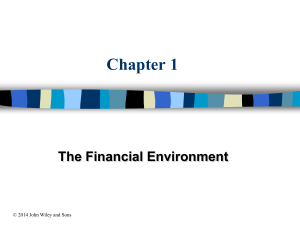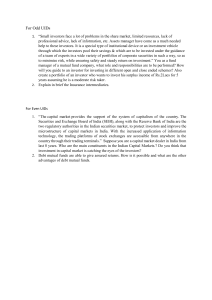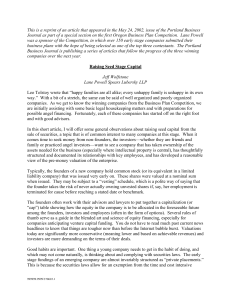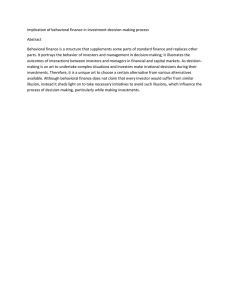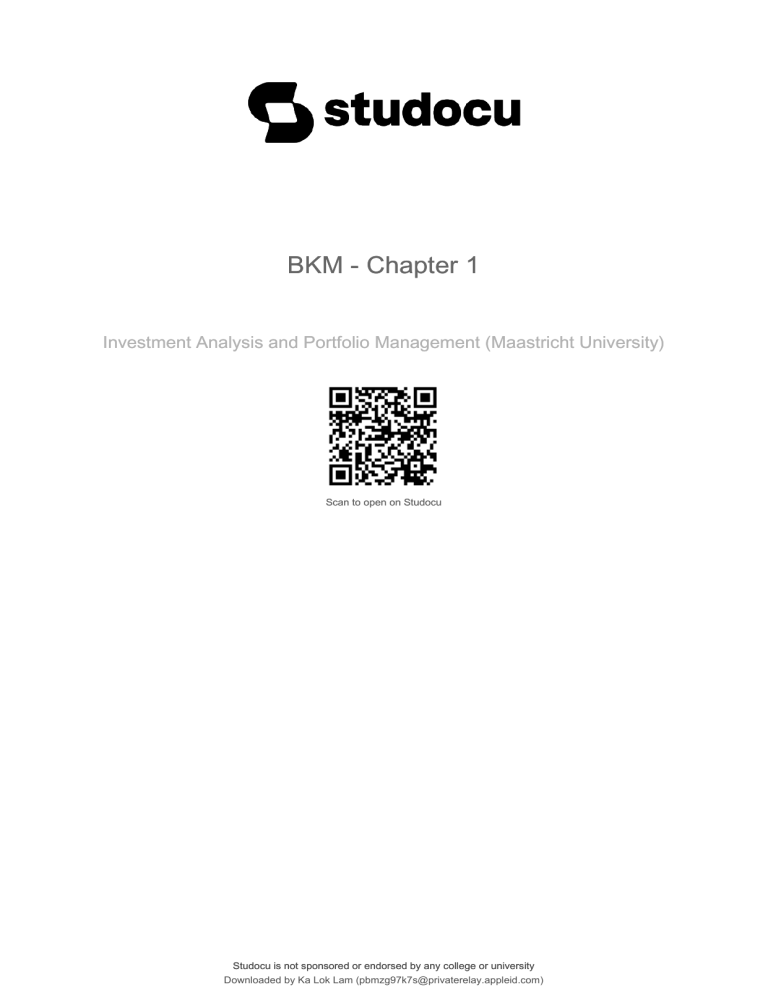
lOMoARcPSD|19987906 BKM - Chapter 1 Investment Analysis and Portfolio Management (Maastricht University) Scan to open on Studocu Studocu is not sponsored or endorsed by any college or university Downloaded by Ka Lok Lam (pbmzg97k7s@privaterelay.appleid.com) lOMoARcPSD|19987906 Week 1 BKM CHAPTER 1 – “INVESTMENTS: BACKGROUND AND ISSUES” Investment Commitment of current resources in the expectation of deriving greater resources in the future key attribute: you sacrifice something of value now for future benefits Real Assets versus Financial Assets Real Assets Assets used to produce goods and services determine productive capacity of an economy Financial Assets Claims on real assets or the income generated by them do not directly contribute to the productive capacity of an economy - While real assets generate net income to the economy, financial assets simply define the allocation of income or wealth among investors Investors’ return on securities ultimately come from the income produced by the real assets that were financed by the issuance of those securities However, these securities, which are financial assets of households, are liabilities of the issuers of the securities Therefore, when we aggregate over all balance sheets, these claims cancel out, leaving only real assets as the net wealth of the economy The successes of failures of the financial assets we choose to purchase ultimately depend on the performance of the underlying real assets Financial Assets There are three broad types of financial assets: Debt Equity Fixed-Income (Debt) Securities - - Pay a specified cash flow over a specific period An ownership share in a corporation Equityholders are not promised any particular payment; they receive any dividends the firm may pay and have prorated ownership in the real assets of the firm The performance of equity investments is tied directly to the success of the firm and its real assets equity investments tend to be riskier than investments in debt securities Derivative Securities - Derivatives The investment performance of debt securities typically is least closely tied to the financial condition of the issuer Nevertheless, debt securities come in a tremendous variety of maturities and payment provisions Equity - Securities providing payoffs that depend on the values of other assets One use of derivatives, maybe the primary use, is to hedge risks or transfer them to other parties Derivatives can also be used to take highly speculative positions, however Investors and corporations regularly encounter other financial markets as well such as the market for foreign exchange, investing directly in real assets etc. Downloaded by Ka Lok Lam (pbmzg97k7s@privaterelay.appleid.com) lOMoARcPSD|19987906 Week 1 BKM CHAPTER 1 – “INVESTMENTS: BACKGROUND AND ISSUES” Financial Markets and the Economy Financial assets allow us to make the most of the economy’s real assets The Informational Role of Financial Markets - - Stock prices reflect investors’ collective assessment of a firm’s current performance and future prospects Market is optimistic share price rises fewer shares must be issued to raise necessary funds smaller proportion of profits are absorbed by new shareholders leaving more for existing making potential investment more attractive Stock prices play a major role in the allocation of capital in market economies, directing capital to the firms and applications with the greatest perceived potential The stock market encourages allocation of capital to those firms that appear at the time to have the best prospects “Markets may be the worst way to allocate capital except for all the others that have been tried” Consumption Timing - Once can “store” his wealth in financial assets to shift his purchasing power from high-earnings periods to low-earnings periods of life Financial markets allow individuals to separate decisions concerning current consumption from constraints that otherwise would be imposed by current earnings Allocation of Risk - - Financial markets and the diverse financial instruments traded in those markets allow investors with the greatest taste for risk to bear that risk, while other, less risk-tolerant individuals can, to a greater extent, stay on the sidelines capital markets allow the risk that is inherent to all investments to be borne by the investors most willing to bear that risk This allocation of risk also benefits the firm when investors are able to select security types with the risk-return characteristics that best suit their preferences, each security can be sold for the best possible price facilitates the process of building the economy’s stock of real assets Separation of Ownership and Management - - Stockholders can sell their shares to other investor, with no impact on the management of the firm financial assets and the ability to buy and sell those assets in the financial markets allow for easy separation of ownership and management Several mechanisms have evolved to mitigate potential agency problems: 1) Compensation plans tie the income of managers to the success of the firm (stock options) 2) While boards of directors have sometimes been portrayed as defenders of top management, they can force out management teams that are underperforming 3) Outsiders such as security analysts and large institutional investors such as pension funds monitor the firm closely and make the life of poor performers at the least uncomfortable 4) Bad performers are subject to the threat of takeover proxy contest Corporate Governance and Corporate Ethics - Market signals will help to allocate capital efficiently only if investors are acting on accurate information Markets needs to be transparent to make informed decisions Sarbanes-Oxley Act in 2002 markets require trust to function Investments in reputation are in fact good business practice Downloaded by Ka Lok Lam (pbmzg97k7s@privaterelay.appleid.com) lOMoARcPSD|19987906 Week 1 BKM CHAPTER 1 – “INVESTMENTS: BACKGROUND AND ISSUES” The Investment Process - Investments can be categorized into broad asset classes, such as stocks, bonds, real estate, commodities, etc. Investors make two types of decisions in constructing their portfolios: Asset Allocation Allocation of an investment portfolio across broad asset classes Security Selection Choice of specific securities within each asset class - “Top-down” portfolio construction starts with asset allocation Average annual return on the common stock of large firms has been about 12% per year Average return on US Treasury bills has been less than 4% BUT are effectively risk-free Security Analysis Analysis of the value of securities - Both bonds and stocks must be evaluated for investment attractiveness, but valuation is far more difficult for stocks because a stock’s performance usually is far more sensitive to the condition of the issuing firm - In the “Bottom-up” strategy, the portfolio is constructed from the securities that seem attractively priced without as much concern for the resultant asset allocation Such a technique can result in unintended bets on one or another sector of the economy However, it does focus the portfolio on the assets that seem to offer the most attractive investment opportunities Markets are Competitive The Risk-Return Trade-Off - Naturally, if all else could be held equal, investors would prefer investments with the highest expected return; however, the no-free-lunch rule tells us that all else cannot be held equal If higher expected return can be achieved without bearing extra risk, there will be a rush to buy the high-return assets, with the result that their prices will be driven up Individuals considering investing in the asset at the now-higher price will find the investment less attractive if you buy at a higher price, your expected rate of return is lower The asset will be considered attractive and its price will continue to rise until its expected return is no more than commensurate with risk At this point, investors can anticipate a “fair” return relative to the asset’s risk, but no more Risk-Return Trade-Off - Assets with higher expected returns entail greater risk When we mix assets into diversified portfolios, we need to consider the interplay among assets and the effect of diversification on the risk of the entire portfolio Diversification means that many assets are held in the portfolio so that the exposure to any particular asset is limited Efficient Markets - Another implication of the no-free-lunch proposition is that we should rarely expect to find bargains in the security markets According to this hypothesis, as new information about a security becomes available, the price of the security quickly adjusts so that at any time, the security price equals the market consensus estimate of the value of the security neither underpriced nor overprices securities existed Downloaded by Ka Lok Lam (pbmzg97k7s@privaterelay.appleid.com) lOMoARcPSD|19987906 Week 1 BKM CHAPTER 1 – “INVESTMENTS: BACKGROUND AND ISSUES” Passive Management Buying and holding a diversified portfolio without attempting to identify mispriced securities Active Management Attempting to identify mispriced securities or to forecast broad market trends - - If markets are efficient and prices reflect all relevant information, perhaps it is better to follow passive strategies instead of spending resources in a futile attempt to outguess your competitors in the financial markets Without ongoing security analysis, however, prices eventually would depart from “correct” values, creating new incentives for experts to move in We may observe only near-efficiency, and profit opportunities may exist for especially insightful and creative investors The Players There appear to be three major players in the financial markets: Firms – net demanders of capital Households – suppliers of capital Governments – borrowers or lenders; depending on the relationship between tax revenue and government expenditure Financial Intermediaries Financial Intermediaries - Institutions that “connect” borrowers and lenders by accepting funds from lenders and loaning funds to borrowers The spread between the interest rates paid to depositors and the rates charged to borrowers is the source of a bank’s profit Financial intermediaries are distinguished from other businesses in that both their assets and their liabilities are overwhelmingly financial Intermediaries simply move funds from one sector to another; the primary social function is to channel household savings to the business sector Advantages of the intermediary role: 1) By pooling the resources of many small investors, they are able to lend considerable sums to large borrowers 2) By lending to many borrowers, intermediaries achieve significant diversification, so they can accept loans that individually might be too risky 3) Intermediaries build expertise throughout the volume of business they do and can use economies of scale and scope to assess and monitor risk Investment Companies - - Firms managing funds for investors; may manage several mutual funds Mutual funds have the advantage of large-scale trading and portfolio management, while participating investors are assigned a prorated share of the total funds according to the size of their investment charge a fixed percentage of assets under management (management fee) Hedge funds are open only to institutional investors and more likely to pursue complex and higher-risk strategies typically keep a portion of trading profits of their fees Downloaded by Ka Lok Lam (pbmzg97k7s@privaterelay.appleid.com) lOMoARcPSD|19987906 Week 1 BKM CHAPTER 1 – “INVESTMENTS: BACKGROUND AND ISSUES” Investment Bankers Investment Bankers - Firms specializing in the sale of new securities to the public, typically by underwriting the issue Investment banking firms advise an issuing corporation on the prices it can charge for the securities issued, appropriate interest rates, and so forth Ultimately, it handles the marketing of the security of the primary market Primary Market A market in which new issues of securities are offered to the public Secondary Market Previously issued securities are traded among investors Venture Capital and Private Equity Venture Capital (VC) - Money invested to finance a new firm Sources of venture capital are dedicated venture capital funds, angel investors and institutions Most venture capital funds are set up as limited partnerships Venture capital investors commonly take an active role in the management of a start-up firm Private Equity Investments in companies that are not traded on a stock exchange The Financial Crisis of 2008 Antecedents of the Crisis - The combination of dramatically reduced interest rates and an apparently stable economy fed a historic boom in the housing market Reduced interest rates had resulted in low yields on a wide variety of investments, and investors were hungry for higher-yielding investments Low volatility and growing complacency about risk encouraged greater tolerance for risk in the search for higher-yielding investments = exploding market for securitized mortgages Changes in Housing Finance Securitization - - - Pooling loans into standardized securities backed by those loans, which can then be traded like any other security (Fennie Mae and Freddie Mac) These were low-risk conforming mortgages eligible loans couldn’t be too big and homeowners had to meet underwriting criteria establishing their ability to repay the loan Securitization by private firms of nonconforming “subprime” loans with higher default risk the investor would bear the risk that homeowners might default on their loans originating mortgage brokers had little incentive to perform due diligence as long as they could sell it When housing prices began falling, these highly leveraged loans were quickly “underwater” the house was worth less than the loan balance, and many homeowners decided to “walk away” Adjustable rate mortgages (ARM) offered borrowers low initial or “teaser” interest rates, but these rates eventually would rest to current market interest yields Starting in 2004, the ability of refinancing to save a loan begin to diminish Higher interest rates put payment pressure on homeowners Housing prices peaked by 2006, so homeowners’ ability to refinance a loan using built-up equity in the house declined Housing default rates began to surge in 2007, as did losses on mortgage-backed securities Downloaded by Ka Lok Lam (pbmzg97k7s@privaterelay.appleid.com) lOMoARcPSD|19987906 Week 1 BKM CHAPTER 1 – “INVESTMENTS: BACKGROUND AND ISSUES” Mortgage Derivatives Who was willing to buy all of these risky subprime mortgages? - Collateralized Debt Obligations (CDOs) were designed to concentrate the credit risk of a bundle of loans on one class of investors, leaving the other investors in the pool relatively protected from that risk prioritized claims on loan repayments by dividing the pool into tranches Why had the rating agencies so dramatically underestimated credit risk in these subprime securities? 1) Default probabilities had been estimated using historical data from an unrepresentative period characterized by a housing boom and an uncommonly prosperous economy 2) The ratings analysts had extrapolated historical default experience to a new sort of borrower pool past default experience was largely irrelevant given these profound market changes 3) There was excessive optimism about the power of cross-regional diversification to minimize risk 4) There were apparent agency problems paid to provide ratings by the issuers not purchasers Credit Default Swaps Credit Default Swap (CDS) - An insurance contract against the default of one or more borrowers CDS became an alternative method of credit enhancement, seemingly allowing investors to buy subprime loans and insure their safety But, in practice, some swap issuers ramped up their exposure to credit risk to unsupportable levels, without sufficient capital to back those obligations The Rise of Systemic Risk - - By relying primarily on short-term loans for their funding, financial institutions needed to constantly refinance their position, or else face the necessity of quickly selling off their less liquid asset portfolios, which would be difficult in times of financial stress Moreover, these institutions were highly leveraged and had little capital as a buffer against losses Many of the assets underlying CDOs were illiquid, hard to value, and highly dependent on forecasts of future performance of other loans difficult to sell in a widespread downturn “Over-the-counter” markets where CDS contracts trade are effectively private contracts between two parties with less public disclosure of positions and less opportunity to recognize either cumulative gains or losses over time or the resultant credit exposure of each trading partners Systemic Risk Risk of breakdown in the financial system, particularly due to spillover effects from one market into others The Shoe Drops - A particularly devastating fallout of the Lehman bankruptcy was on the “money market” for short-term lending rush out of commercial paper into Treasury bills shutting down shortterm financing markets banks found it difficult to raise funds thousands of small businesses became unable to finance their normal business operations crisis reached real economy The Doff-Frank Reform Act (2010) It calls for stricter rules for bank capital, liquidity, and risk management practices It mandates increased transparency It attempts to limit the risky activities in which banks can engage (Volcker Rule) It seeks to unify and clarify lines of regulatory authority and responsibility in one or smaller number of government agencies It addresses incentive issues to discourage excessive risk taking by large financial institutions It addressed incentives of the bond rating agencies Downloaded by Ka Lok Lam (pbmzg97k7s@privaterelay.appleid.com)


